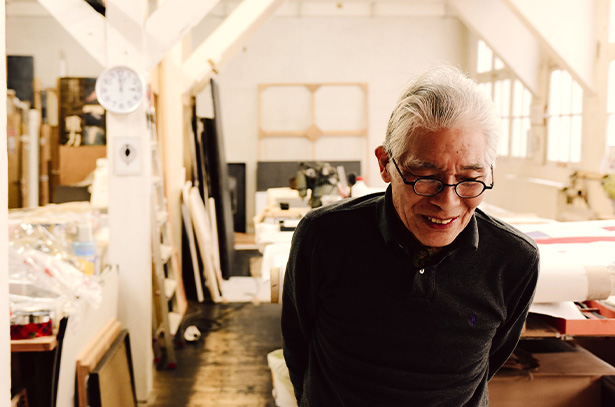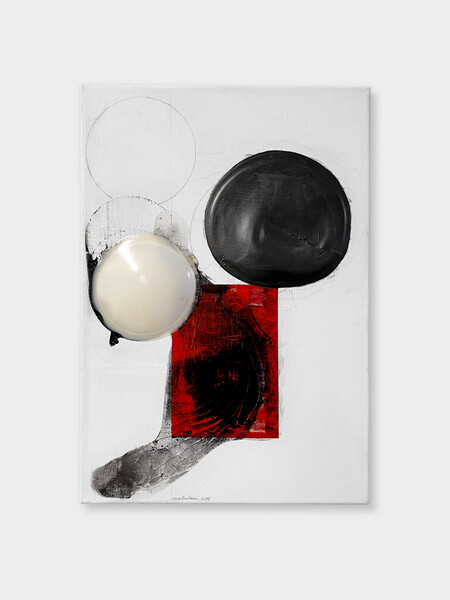
Takesada Matsutani
Stream
14 April 2020
Online Exhibition
With the online exhibition, ‘Stream’, Ōsaka-born and Paris-based artist Takesada Matsutani presents a series of previously unseen works, alongside a significant body of preparatory drawings, multi-media paintings and lithographs, dating from the 1970s to present day. Organised with Olivier Renaud-Clément, the intimate presentation embodies Matsutani’s intuitive and enduring connection with his materials over the past six decades, including a new work created in the artist's studio and home during this period of isolation.
The artist’s unique visual language forms one of the most pioneering oeuvres to emerge from post-war Japan and is continually celebrated globally. The online exhibition follows Matsutani’s retrospective survey at the Centre Pompidou, Paris in Summer 2019 and coincides with the re-opening of ‘Takesada Matsutani: Prints, 1967-1977’ at les Abattoirs, Toulouse, in partnership with the National Institute of Art History, France (INHA). The artist’s work is also featured in our current group presentation at Hauser & Wirth Hong Kong, open until 30 May.
Buddhist teachings were a central element in Matsutani’s childhood education, with our existence seen as a constantly changing current. Although he doesn’t consider himself a Zen practitioner in his art, he has felt a profound affinity with the philosophy’s call for a ‘return to the simplicity of everyday experience,’ its rejection of ‘system-based thinking,’ and its emphasis on ‘a constant moment-to-moment praxis.’ In his multifaceted works, Matsutani attempts to stop time, to materialise a suspended moment and acknowledge the repetition and fluidity of everyday life. Talking about whether the current global pandemic has changed his practice Matsutani says: 'a little bit at first, but I find my routine is the same and focus on the work is the same. In the end, the beauty is still there and continues to exist.'
From the early 1960s until the 1970s, Matsutani was a key member of the influential post war Japanese art collective, the Gutai Art Association. As part of the Gutai group, Matsutani experimented with vinyl glue, using fans and his own breath to manipulate the substance, creating bulbous and sensuous forms reminiscent of human curves and features. Matsutani moved to Paris in 1966, and after the group disbanded in 1972, he eased into a radical yet consistent new body of drawing and printmaking. When Matsutani moved to Europe, with limited resources, he was compelled to reconsider the essential tools of art making. The inexpensive materials of graphite and paper allowed him to discover the immediacy of monochrome drawing. As he explains, in those years he had more time than money. What better than to go back to basics? Inexpensive pencils and white paper, the patient work of drawing.
Matsutani began creating vast expanses of metallic black graphite on mural-size sheets of paper built up with painstaking individual strokes, commonly known as his Stream series. The successive layers produce a sense of volume through the interplay of shadows and the direction of the pencil strokes, developing a tactility and inner luminosity as seen in the earliest work in the online presentation, ‘Stream 78-1’ (1978) and ‘Stream 99-5’ (1999). This ritualised manner of mark-making has a performative gesture that presents a time-based record reminiscent of Matsutani’s artistic beginnings in Japan. The first Streams were small format drawings, later evolving into impressive installations, of which the most monumental were presented at the 2017 Venice Biennale and the artist’s retrospective at the Centre Pompidou, Paris in 2019.
In keeping with his Gutai roots, Matsutani strove to identify and convey the essential character and expressive possibilities between vinyl adhesive and graphite. It is this confluence of materials, as seen in recent works ‘Propagation 15-2-5’ (2015) and ‘EVOLUTION-99’ (1999), that epitomizes the distinctive visual language the artist has made his own over the last 40 years. Alongside Matsutani’s rediscovery of the power of black and white, he also started to adopt bright colour planes and shaped canvases with a very personal palette, this is highlighted in ‘Three Circles-19’ (2019), photographed in the artist’s studio in the past month during isolation.
Related Content
About the Artist

Takesada Matsutani
From the early 1960s until the 1970s Matsutani was a key member of the ‘second generation’ of the influential post war Japanese art collective, the Gutai Art Association. Over five decades Matsutani has developed a unique visual language of form and materials. As part of the Gutai group, Matsutani experimented with vinyl glue, using fans and his own breath to manipulate the substance, creating bulbous and sensuous forms reminiscent of human curves and features.
In 1966, Matsutani received a grant from the French government after winning first prize in the 1st Mainichi Art Competition and subsequently moved to Paris where he began working at Stanley William Hayter's renowned printmaking studio, Atelier 17. During the four years he worked at the studio, he learnt French, married and established his base in Paris. Working alongside Hayter opened Matsutani up to a new form of artistic experimentation and offered him a newfound confidence. Matsutani began to rethink his practice and a new elemental aesthetic language began to emerge that was both controlled and organic.
After the Gutai group disbanded in 1972, Matsutani eased into a radical yet consistent new body of work, informed by his experience at Atelier 17. Faithful to his Gutai roots, he strove to identify and convey the essential character of vinyl glue with graphite, that were to become his signature materials. Matsutani began creating vast expanses of metallic black graphite on mural-size sheets of paper built up with painstaking individual strokes. This ritualized manner presents a time-based record of his gestures, while reminiscent of his artistic beginnings in Japan, it has been translated into an artistic language that is uniquely his own.
Current Exhibitions
1 / 12













